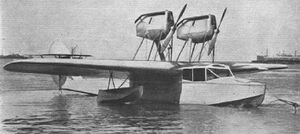Engineering:Saro Cutty Sark
| A17 Cutty Sark | |
|---|---|

| |
| Role | Amphibian |
| Manufacturer | Saunders-Roe |
| First flight | 4 July 1929 |
| Introduction | 1930 |
| Number built | 12 |
The Saro A17 Cutty Sark was a British amphibious aircraft from the period between World War I and World War II, built by the British firm Saunders-Roe (also known as SARO). The aircraft was named after the ship Cutty Sark, rather than the garment or the fictional witch.
Development
In 1928, Sir Alliot Verdon Roe sold Avro. He bought an interest in S. E. Saunders, flying boat manufacturers based at Cowes, Isle of Wight, southern England; the company was renamed Saunders-Roe. The A17 Cutty Sark was the new company's first design. It was a shoulder-winged four-seat amphibian monoplane with an all-metal hull and plywood covered wings. The above-wing pylon-mounted engines could easily be changed, and a variety of different engines were used to power Cutty Sarks, including 104 hp Cirrus Hermes Mk 1s and 120 hp de Havilland Gipsy IIs. The Saro A19 Cloud was developed from this design.
Only 12 Cutty Sarks were built, and none lasted long in service, but the type nevertheless saw service with many users in the United Kingdom , Australia , Canada , New Zealand, China , Japan and the Dominican Republic.
Production aircraft
- A17/1 : The prototype G-AAIP was first flown 4 July 1929. Bought by Captain Campbell Shaw and Flight Lieutenant Tommy Rose for Isle of Man Air Services. Returned to Cowes in 1933 after being damaged by floating timber.
- A17/2 : VH-UNV was exported to Australia by Matthews Aviation flying the Bass Strait between Melbourne and Tasmania from May 1930. On 8 November 1931 the aircraft was driven by wind into a pier at St. Kilda, and Mr E. Lloyd, a passenger who attempted to assist, was killed by a propeller. In 1935 it was sold to Pioneer Air Services. In 1937 it was sold to Keith Caldwell, a young barnstorming pilot from Lindfield NSW (not to be confused with the NZ WWII fighter ace of the same name);[1] on 15 October 1937, at the same time as he joined Qantas as a pilot, Caldwell sold VH-UNV for £700 to the airline as a trainer. It was written off after landing on water with the undercarriage extended on 5 April 1938.
- A17/3 : a.k.a. "L3". Sold to the RNZAF. It was first flown on 3 March 1930, then shipped to New Zealand aboard the SS Mataroa, where it was reassembled by 28 May 1930. It operated from Hobsonville, Auckland, for the next six years. After 221 hours and 5 minutes flying time it was judged worn out beyond economic repair. L3 made its last flight on 23 November 1936, after which it served as an instructional airframe. It was scrapped in 1939.
- A17/4 : G-AAVX before being sold to Singapore as VR-SAA in 1930.
- A17/5 : G-ABBC named "Progress I" operated out of Blackpool to the Isle of Man by British Amphibious Airlines. Attempts to replace it with an A.19 Cloud after 1933 were blocked due to SARO's decision to operate an airline from the Isle of Man.
- A17/6 : Acquired by the Royal Air Force as S1575.
- A17/7 : Sold to Hong Kong as VR-HAY
- A17/8 : Served in the Kwangsi Air Force in China , but was returned to Britain as G-AETI.
- A17/9 : Registered G-ABVF and sold to a Japanese aviator and named Hochi-Nippon for a trans-Pacific flight but it was wrecked in Oakland, CA. California. Sole single-engine example.
- A17/10 : Registered G-ACDP to Air Service Training Ltd., used by No 3 E & RFTS until 1942. Fitted with radial engines.
- A17/11 : Registered G-ACDR to Air Service Training Ltd., used by No 3 E & RFTS until 1942.
- A17/12 : Registered G-ADAF. This may be the machine exported to the Dominican Republic in 1935, and written off in 1942.
Operators
Military operators
 Dominican Republic
Dominican Republic
- Dominican Air Force - One aircraft.
 New Zealand
New Zealand
 United Kingdom
United Kingdom
Specifications (A.17M – Genet Major engines)
Data from British Civil Aircraft 1919–1972: Volume III,[2] Saunders and Saro aircraft since 1917[3]
General characteristics
- Crew: 2
- Capacity: 2 pax / 510 lb (231 kg) payload
- Length: 34 ft 4 in (10.46 m)
- Wingspan: 45 ft 0 in (13.72 m)
- Height: 11 ft 2 in (3.40 m)
- Wing area: 320 sq ft (30 m2)
- Empty weight: 2,725 lb (1,236 kg)
- Gross weight: 3,865 lb (1,753 kg)
- Fuel capacity: 40 imp gal (48 US gal; 182 l) in two wing tanks
- Powerplant: 2 × Armstrong-Siddeley Genet Major 7-cylinder air-cooled radial piston engines, 140 hp (100 kW) each
- Propellers: 2-bladed wooden fixed-pitch propellers
Performance
- Maximum speed: 107 mph (172 km/h, 93 kn)
- Cruise speed: 93 mph (150 km/h, 81 kn)
- Range: 315 mi (507 km, 274 nmi)
- Service ceiling: 9,000 ft (2,700 m)
- Rate of climb: 500 ft/min (2.5 m/s)
See also
Related lists
- List of aircraft of the Royal Air Force
- List of aircraft of the Royal New Zealand Air Force and Royal New Zealand Navy
- List of aircraft of World War II
- List of flying boats and floatplanes
References
- Notes
- ↑ Recorded conversation with Keith Caldwell 8/92
- ↑ Jackson, A. J. (1974). British civil aircraft 1919–1972 Volume III (2nd ed.). London: Putnam. p. 123. ISBN 978-0-370-10014-2.
- ↑ London, Peter M. (1988). Saunders and Saro aircraft since 1917 (1st ed.). London: Putnam. pp. 96–109. ISBN 0851778143.
- Bibliography
- Jackson, A.J. British Civil Aircraft 1919–1972: Volume III. London:Putnam, 1988. ISBN:0-8517-7818-6.
- London, Peter. Saunders and Saro Aircraft since 1917. London: Putnam, 1988. ISBN:0-85177-814-3
 |


